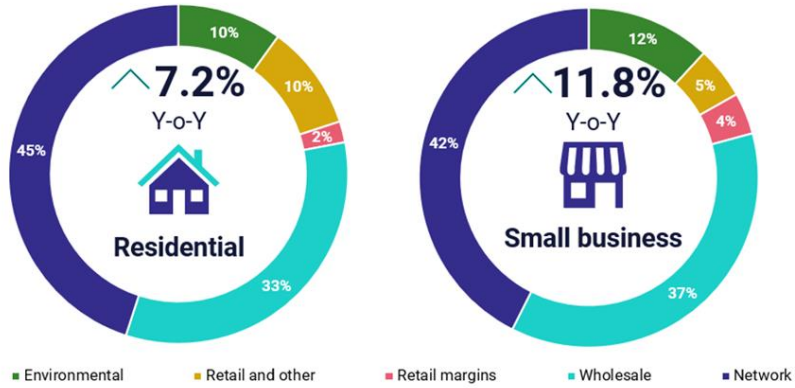KEY POINTS
- The wholesale electricity price is the price an electricity supplier pays when purchasing electricity from the NEM — the supplier then marks up the price and resells it to customers.
- There are two main rates that an electricity provider charges customers on their power bill — usage charges and supply charges.
- Each year on July 1, the AER releases new DMO and VDO reference prices, which providers refer to when setting the rates on their market offers and are the maximum they can charge on a standing offer.
Energy companies have a number of costs and overheads to cover, which then get passed on to the customer. Knowing about these expenses can help you make informed decisions about which provider you choose to supply your power.
On this page:
- What is the wholesale electricity price?
- What is the wholesale electricity market (NEM)?
- How does an electricity retailer determine its rates?
- How are usage charges set?
- How are supply charge set?
- What do electricity plans look like?
- Can my energy retailer change my rates at any time?
- Can I buy wholesale electricity rates instead?
- How can I ensure I am paying a good rate for electricity?
- Why are electricity prices increasing?
What is the wholesale electricity price?
The wholesale electricity price is when an electricity supplier purchases electricity from the National Electricity Market (NEM), then sells that on to customers at a marked-up price.
The mark-up price covers the generation and transportation of energy via electrical poles and wires, as well as retailer expenses and government schemes.
Lastly, the cost is adjusted to include the energy provider’s profit.
What is the national electricity market (NEM)?
The NEM transports wholesale electricity from generators to electricity distributors in each distribution zone, excluding Western Australia and the Northern Territory.
The output of all generators is sent to a ‘pool’, or spot market, where the electricity demand is scheduled at five-minute intervals. This scheduling ensures that production matches consumer requirements. This is where the current energy price is calculated.
How does an electricity provider determine its rates?
There are two main rates that an electricity provider will charge customers on their power bill — these are known as the usage charges and supply charges.
- Usage charge: This accounts for the energy that has been used by the household, whether that be through lighting, heating or running the dishwasher.
- Supply charge: This refers to the cost paid for having electricity supplied to the home from the grid. This is paid at a daily rate and can fluctuate depending on the distribution network a household is located in.
Usage charges are measured by kilowatt hour (kWh), with some tariffs charging higher or lower amounts for this rate, depending on the time of day the energy was used.
How are usage charges set?
To set a usage charge, an electricity retailer must first purchase electricity from the NEM to resell. Wholesale rates are largely determined by supply and demand, but are regulated by government and industry regulators.
The wholesale rate of electricity is set every five minutes, meaning prices will shift as demand increases (i.e., during peak evening periods). There are steps after purchasing a wholesale rate that a power provider will take before finalising the usage rates shown on a bill.
- The retailer purchases electricity from the NEM and adds on additional charges, including a margin of profit.
- Additional charges are then reviewed by the state regulator (in regulated markets) before the usage rate is offered to the public. This is the main difference between regulated and deregulated energy.
- GST (10%) is then added, as well as any state-based government expenses.
The combination of these costs then make up the final usage rate charged by the retailer on a bill.
Energy retailers need to negotiate and bid on wholesale supply rates in order to secure rates for their customers.
As such, if the market experiences unforeseen circumstances that contribute to higher pricing (e.g. increased demand or blackouts) it may dramatically affect their customers’ usage rates, especially if a retailer cannot accommodate the elevated price.
How are supply charges set?
Supply charges are based on the applicable network charges for a distribution network. Different areas are managed by different distributors, which means network charges can vary considerably depending on location.
According to the Australian Competition and Consumer Commission (ACCC), a typical electricity bill for an average residential customer can include: network costs (45%), wholesale costs (33%), environmental costs, retail costs (10%) and retail margins (2%). This breakdown will vary depending on the retailer and market structure in each state.

Source: accc.gov.au
Competition in the electricity sector means energy retailers are competing to get the cheapest wholesale rates, while trying to minimise the company’s retail expenses. Recent rate rises in some areas have been largely attributed to increased infrastructure spending by networks, forcing supply charges to go up.
What do electricity plans look like?
There are two types of electricity plans for customers to choose from: market offers and standard offers.
Market offers typically include incentives with a benefit period of 12-24 months. Energy prices usually change once the benefit period has ended.
Standard (or standing contracts) are regulated plans with less competitive rates that lack incentives. Customers will automatically be switched to a standard offer when the benefit period on their market offer ends and isn’t renewed.
Standing offer plans in SEQ, NSW and SA are also known as Default Market Offers (DMO) and Victorian Default Offers (VDO) in Victoria.
Can my energy retailer change my rates at any time?
If you are on a variable rate electricity plan, your retailer can change your rates at any time. However, your retailer must provide you with written notice of the rate change at least five business days before the new rate takes effect.
With a fixed rate electricity plan, however, usage and supply charges are locked in for an extended benefit period – typically 12-24 months, and can’t be changed during this period.
All retailers are required to adjust their standing or default electricity pricing every year on July 1 in line with the new reference price. The reference prices are determined by various factors, such as the average energy usage for each distribution zone.
This is the maximum or capped price a retailer can charge customers for power annually.
Can I buy wholesale electricity rates instead?
There are some retailers that offer residential bill-payers access to wholesale electricity rates in exchange for a membership fee or additional cost component.
Providers that currently allow customers to ‘buy’ wholesale electricity rates include Energy Locals and Amber Electric.
You might also be interested in:
How can I ensure I am paying a good rate for electricity?
A ‘good’ rate for power will differ for every household, depending on size, location and annual energy usage.
By regularly comparing the rates available from different providers on the market, you’ll be able to find the best electricity usage rate for you.
It’s especially important to have a look at your options if you receive a notice from your provider of an upcoming price change, just to make sure you are still paying a competitive rate.
If you are interested in seeing what’s on offer in your area, you can start by clicking on the tab for your state on the Canstar Blue tool below.
Here are some of the cheapest published deals from the retailers on our database that include a link to the retailer’s website for further details. These are products from referral partners†. These costs are based on the Ausgrid network in Sydney but prices may vary depending on your circumstances. This comparison assumes general energy usage of 3900kWh/year for a residential customer on a single rate tariff. Please use our comparison tool for a specific comparison in your area. Our database may not cover all deals in your area. As always, check all details of any plan directly with the retailer before making a purchase decision.
Here are some of the cheapest published deals from the retailers on our database that include a link to the retailer’s website for further details. These are products from referral partners†. These costs are based on the Citipower network in Melbourne but prices may vary depending on your circumstances. This comparison assumes general energy usage of 4000kWh/year for a residential customer on a single rate tariff. Please use our comparison tool for a specific comparison in your area. Our database may not cover all deals in your area. As always, check all details of any plan directly with the retailer before making a purchase decision.
Here are some of the cheapest published deals from the retailers on our database that include a link to the retailer’s website for further details. These are products from referral partners†. These costs are based on the Energex network in Brisbane but prices may vary depending on your circumstances. This comparison assumes general energy usage of 4600kWh/year for a residential customer on a single rate tariff. Please use our comparison tool for a specific comparison in your area. Our database may not cover all deals in your area. As always, check all details of any plan directly with the retailer before making a purchase decision.
Here are some of the cheapest published deals from the retailers on our database that include a link to the retailer’s website for further details. These are products from referral partners†. These costs are based on the SA Power network in Adelaide but prices may vary depending on your circumstances. This comparison assumes general energy usage of 4000kWh/year for a residential customer on a single rate tariff. Please use our comparison tool for a specific comparison in your area. Our database may not cover all deals in your area. As always, check all details of any plan directly with the retailer before making a purchase decision.
Why are electricity prices increasing?
When the DMO or VDO increases, it’s due to increased costs for generators and distributors, which then increases the average energy usage cost. Then, when the reference price increases, energy retailers have a higher price cap for charging customers.
Poor weather conditions can also influence the price of electricity. Overcast days reduce solar output, creating more strain on the electricity grid and driving up demand. If you have solar panels installed, a good way to avoid solar energy loss is to have a solar battery installed.
The best way to keep your electricity price as low as possible is to ensure you are on the cheapest energy plan for your household’s needs. If you haven’t compared your energy plan in the last year, there’s a chance that you are on your provider’s standard plan.
If you aren’t sure of what your plan’s usage rates are, input your details in the Canstar Blue comparison tool below. You will also be able to compare your usage rates with the cheapest on the market.
Original reporting by Brendon O-Neill
Image Source: accc.gov.au, BJ.Photo/Shutterstock.com



Share this article